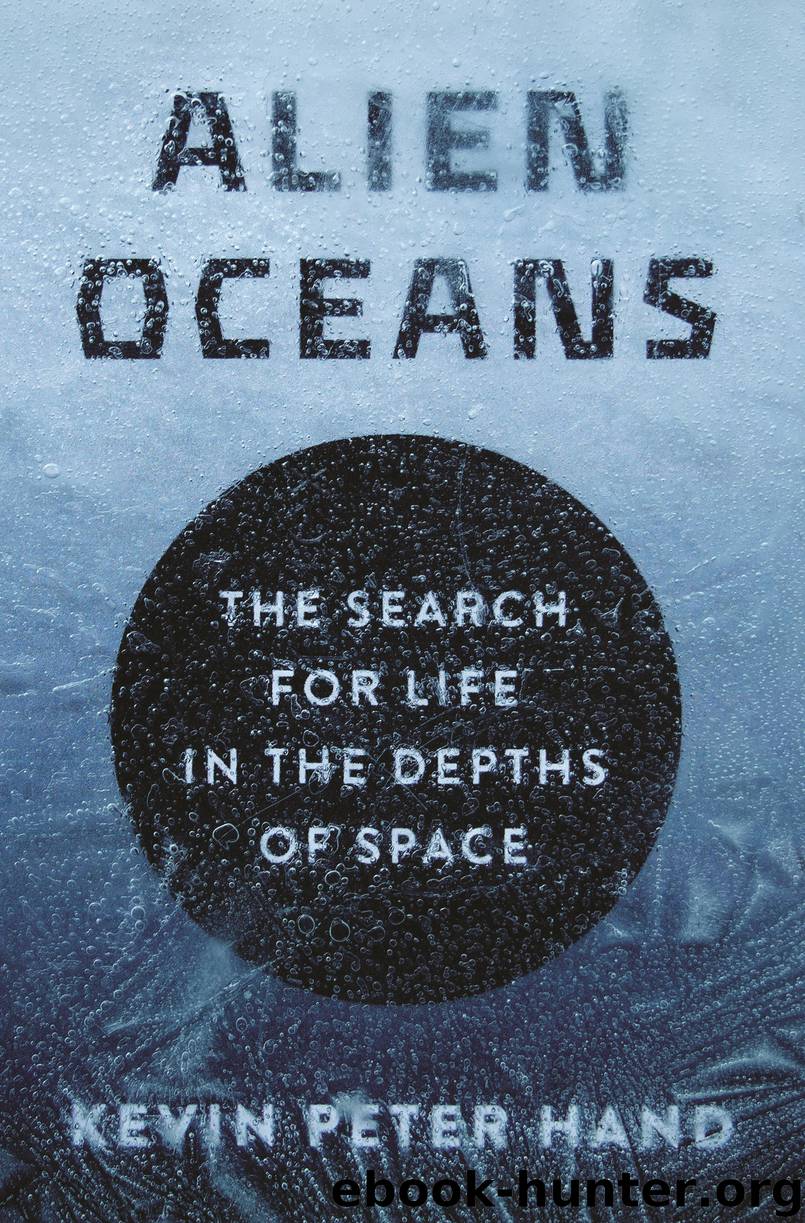Alien Oceans by Kevin Hand

Author:Kevin Hand
Language: eng
Format: epub
Publisher: Princeton University Press
Published: 2020-01-27T00:00:00+00:00
CHAPTER 10
ORIGINS IN AN ALIEN OCEAN
There is a place on Earth that could be a window back in time. A window to the conditions that may have given birth to life. A window not only into life’s origins on Earth, but also possibly its origin in alien oceans.
If the origin of life is possible around a hydrothermal vent, then the magical landscape of the Lost City hydrothermal vents, one kilometer below the surface of the Atlantic Ocean, might be that window. Lost City contains the kind of hydrothermal vents that we think could exist deep within the ocean worlds of the outer solar system.
I had the opportunity to dive down to Lost City in the summer of 2003; it was one of the most awe-inspiring experiences of my life. Lost City is a field of hydrothermal vent towers, made of glistening white carbonate rock. Some of the towers rise well over 100 feet above the seafloor, giving the impression of ancient cathedrals dotting this beautiful landscape. The name is perfect for this site—it looks like a lost civilization, hiding away in the depths of our ocean.
From a distance, the carbonate has a texture that reminds me of wax candles with solidified drips along the side. The work of the Spanish architect Antoni Gaudí, and in particular his magnificent Sagrada Familia cathedral, is the closest thing I can think of that resembles the tall towers of Lost City. It is a truly magnificent environment. And it’s at the bottom of the ocean.
On this particular occasion, we were doing a dive that involved two relatively new submersibles called the Deep Rovers. This dive was part of James Cameron’s expedition in 2003, and we had a total of four submersibles making simultaneous dives. Never before had four submersibles been deployed at the same time, at the same site. It was a bold and risky plan. The two Russian Mir submersibles were reliable but not immune to problems. The two Deep Rovers—one of which had me as cargo—were not well-tested, especially at the depth of the Lost City vents. Lots of things could go wrong.
The Deep Rover is essentially a glass sphere that can seat two people. It provides an incredible experience in the ocean because you can look around in any direction—you’ve got a full field of view. Unlike more traditional submersibles, you’re not constrained to one or two tiny portholes to see the ocean. In a Deep Rover you feel as though you are in an inverted aquarium—we’ve transported our air-rich environment from the surface into the ocean, and the fish can look in on us the same way we stare into an aquarium.
The Deep Rover I was in, with pilot Tym Caterson, was deployed first. This meant that we got to the bottom of the ocean before anyone else and had some time to collect samples and explore before the full coordinated effort with the other three submersibles.
Tym and I found a nice spot on the bottom of the ocean, with one of the carbonate chimneys towering above us.
Download
This site does not store any files on its server. We only index and link to content provided by other sites. Please contact the content providers to delete copyright contents if any and email us, we'll remove relevant links or contents immediately.
| Aeronautics & Astronautics | Astronomy |
| Astrophysics & Space Science | Comets, Meteors & Asteroids |
| Cosmology | Mars |
| Solar System | Star-Gazing |
| Telescopes | UFOs |
Tools of Titans by Timothy Ferriss(8295)
Turbulence by E. J. Noyes(7972)
Secrets of Antigravity Propulsion: Tesla, UFOs, and Classified Aerospace Technology by Ph.D. Paul A. Laviolette(5328)
Astrophysics for People in a Hurry by Neil DeGrasse Tyson(5147)
Room 212 by Kate Stewart(5063)
Design of Trajectory Optimization Approach for Space Maneuver Vehicle Skip Entry Problems by Runqi Chai & Al Savvaris & Antonios Tsourdos & Senchun Chai(5032)
Pale Blue Dot by Carl Sagan(4944)
The David Icke Guide to the Global Conspiracy (and how to end it) by David Icke(4650)
A Journey Through Divination and Astronomy by Publishing Pottermore(4361)
Goodbye Paradise(3757)
Apollo 8 by Jeffrey Kluger(3659)
COSMOS by Carl Sagan(3581)
Losing the Nobel Prize by Brian Keating(3514)
The Five People You Meet in Heaven by Mitch Albom(3513)
How to Read Water: Clues and Patterns from Puddles to the Sea (Natural Navigation) by Tristan Gooley(3427)
Brief Answers to the Big Questions by Stephen Hawking(3387)
How to Read Nature by Tristan Gooley(3286)
The Order of Time by Carlo Rovelli(3160)
A Brief History of Time by Stephen Hawking(2988)
